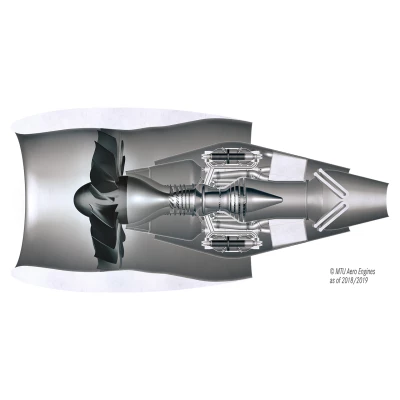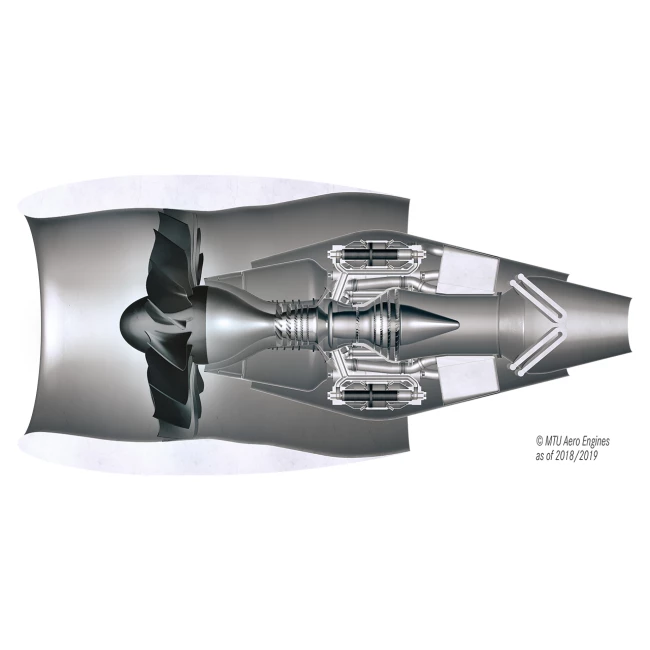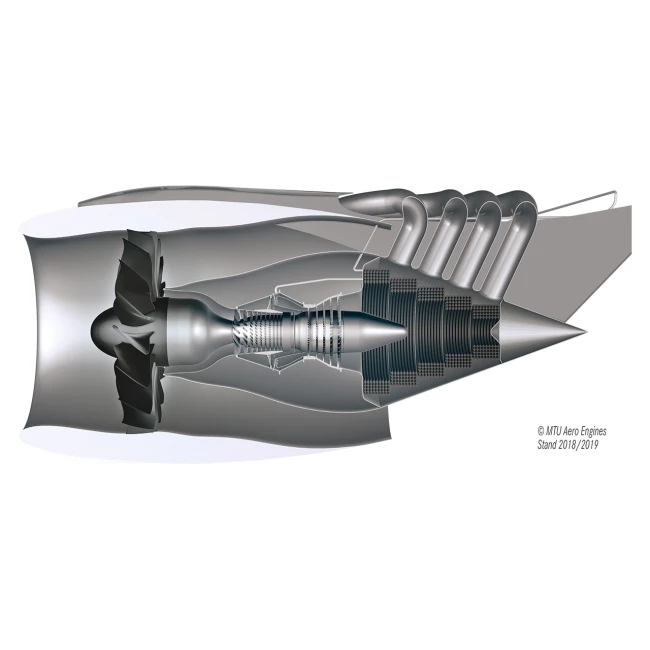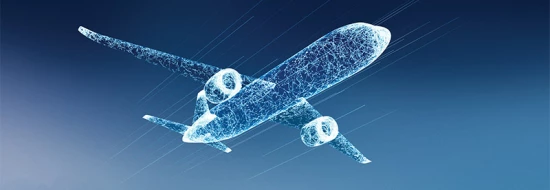innovation
Thrust for the future
“Answering tomorrow’s challenges”: For MTU Aero Engines, this principle is both a motto and a responsibility. Never before has the company had such good answers ready as today.
06.2019 | author: Martina Vollmuth | 10 mins reading time
author:
Martina Vollmuth
holds a degree in journalism and trained as a copy editor for daily newspapers. She is the official spokeswoman for technology at MTU.

For decades, three letters in aviation have stood for innovative engine solutions: MTU. The engine experts in Munich have really made a name for themselves over the years, repeatedly coming up with valuable technological innovations. With their contributions to the Geared Turbofan™ (GTF) engine, they are impressively shaping developments in the industry of the present while preparing to shape the future like never before in the company’s history: MTU’s unique expertise means it is ideally placed to tackle the key missions of today and tomorrow: making commercial engines even more efficient and environmentally friendly and military engines even more powerful.
- RB199 development: the engine that started it all
- Low-pressure turbines: The path to world-class manufacturer
- Blisk development: How blade and disk became one
- Geared Turbofan: How the engine of the future was developed
- Additive manufacturing: Printing a component, layer by layer
- Thrust for the future
“Never has MTU had such a definitive technology roadmap as today,” explains COO Lars Wagner. “We’re conscious of our responsibility for sustainable, emissions-free flying. That’s why we’re already investing today in pioneering technologies for the aviation of tomorrow.” Wagner explains that, from 2030 onward, the commercial segment will be clearly oriented toward the next generation of the Geared Turbofan™, while in the military segment it is the NEFE (Next European Fighter Engine) that will determine the company’s direction. He continues: “In the commercial segment, we’re researching several evolutionary approaches that are already possible today thanks to sustainable e-fuels. At the same time, we’re looking into alternative engine concepts ranging from hybrid-electric flight to fuel cells.”
“Never has MTU had such a definitive technology roadmap as today.”
Profile of commercial aviation in 2050
However, MTU’s experts are not satisfied to leave it at that; they are casting their gazes further into the future. Part of a small band of visionaries worldwide, they are already working with partners from industry and research on ideas for the commercial engines that could fly from 2050 onwards. Wagner explains: “MTU is working out revolutionary engine concepts to achieve the ambitious goals of Flightpath 2050.” These new engine solutions have to go beyond today’s technology, with emissions-free flight the greater goal.
The MTU experts have several specific engine concepts in view, including the composite cycle and the steam-injected and water-recovering gas turbine. Such “revolutionary” solutions involve entirely new technology. By contrast, MTU characterizes the further development of the existing Geared Turbofan™ technology as “evolutionary”: the second GTF generation still offers considerable potential. Once it has been further optimized, it will dramatically reduce emissions and is due to be airborne by the mid-2030s.
Then there will need to be a technological leap forward to develop technologies and concepts that will pave the way for largely emissions-free flight—this is the responsibility of the European aviation industry. Resourceful MTU developers have come up with two approaches and are combining the tried-and-tested gas turbine engine with brand new technologies: in the composite cycle approach, the conventional high-pressure compressor system is to be supplemented by a piston compressor and engine. “This will allow us to significantly increase thermal efficiency,” says Dr. Stefan Weber, Senior Vice President Technology & Engineering Advanced Programs in Munich. The steam-injected and water-recovering gas turbine, meanwhile, integrates a steam power process into the gas turbine processes. This involves using a gas turbine with steam injection to feed the heat of the exhaust stream back into the process inside the engine. The wet combustion would substantially reduce both CO2 and NOx pollutant emissions. “We’ll have to see which approach ultimately offers greater potential and is economically feasible,” Weber says. If this turns out to be the steam-injected and water-recovering gas turbine, it will not work in the current aircraft architecture, thus calling for a new configuration.
Sustainable, renewable fuels
Work on these two MTU pilot concepts is being accompanied by other activities. “These measures alone won’t be enough for us to reach the ambitious goals for 2050,” says Weber. “They will get us a good part of the way there, but by no means will they let us achieve them completely. We need to close the remaining gap through the development of sustainable fuels.” The idea is to shift away from consuming fossil fuels toward sustainable, renewable fuels. “We want to encourage their use,” Weber says. Promising approaches for producing synthetic fuels are offered by solar energy and by electricity—provided it is generated sustainably. The latter technology is already available today. One of the major advantages of synthetic fuels is that they don’t require any new infrastructure; they can simply be “dropped in” to existing petroleum-based infrastructure. To completely cut out NOx emissions as well, there’s no getting away from fuel cells—meaning flying with hydrogen. MTU has this technology in its sights, too.
Profile of commercial aviation in 2050


Composite Cycle Engine: Combining gas turbines and piston machines is an approach that dates back to the 1950s—however, today’s commercial aircraft require a much higher level of performance. MTU has developed and patented a new concept for this combination.

Composite Cycle Engine: Combining gas turbines and piston machines is an approach that dates back to the 1950s—however, today’s commercial aircraft require a much higher level of performance. MTU has developed and patented a new concept for this combination.


Steam-injected and water-recovering gas turbine: Steam-injected and water-recovering gas turbine refers to the integration of a steam process into the gas turbine. The idea is to use the energy from the exhaust to increase power output. It should also considerably reduce pollutant emissions in the process.

Steam-injected and water-recovering gas turbine: Steam-injected and water-recovering gas turbine refers to the integration of a steam process into the gas turbine. The idea is to use the energy from the exhaust to increase power output. It should also considerably reduce pollutant emissions in the process.
E-flying
One topic has been gaining more and more public attention recently: electric flying. This is because purely battery-driven aircraft fly completely emissions-free—provided the electricity they use has been generated sustainably. “Emissions-free” does not include noise, as this simply cannot be fully avoided when it comes to flight. Realistically, however, from today’s perspective there are large obstacles to overcome before we will see purely battery-powered passenger aircraft. Weber elaborates: “Electric propulsion systems and batteries reach performance levels today that permit their use in power gliders, sporting airplanes and other aircraft in that class.” But at present, transferring this technology into aircraft in the Airbus A320 class is impossible, as the battery capacity falls far short of what’s needed. “And we currently see no promising technological approaches opening up in the future.”
What does seem technically feasible from today’s perspective are turbo-electric or hybrid-electric systems that integrate the turbomachinery and generator into the aircraft fuselage. The current for the electric motors could be generated by a gas turbine; in turn, the electric motors would power distributed fans on the wing. Whether there is truly potential to be tapped with this approach remains to be seen. Success ultimately hinges on technical progress in the field of batteries and electric motors. MTU has its finger on the pulse here, too, and is involved in various studies and initiatives: for example, it is collaborating with partners to investigate hybrid-electric or all-electric powertrains for air taxis or even 19-seater aircraft.
Weber is certain about one thing: “As a concept, the gas turbine engine will continue to hold sway. It’s fit for the future and holds potential for further optimization.” Using sustainable drop-in fuels with the existing infrastructure would make it possible to quickly put a significant dent in pollution emissions. There are two conceivable applications for the gas turbine in aircraft: either as an improved, greener main engine or else as the basis for low-emissions hybrid systems, insofar as their introduction is proven to be beneficial overall.
MTU has positioned itself clearly: it remains true to itself and its tradition, and is eyeing all possibilities for ensuring further progress in the skies. After all, as the experts know, the future of aviation begins today.








